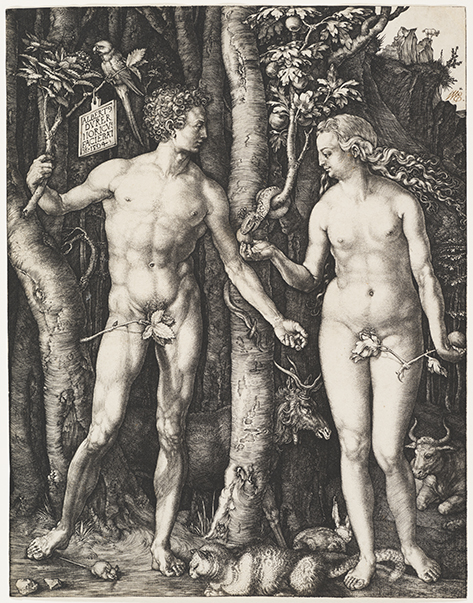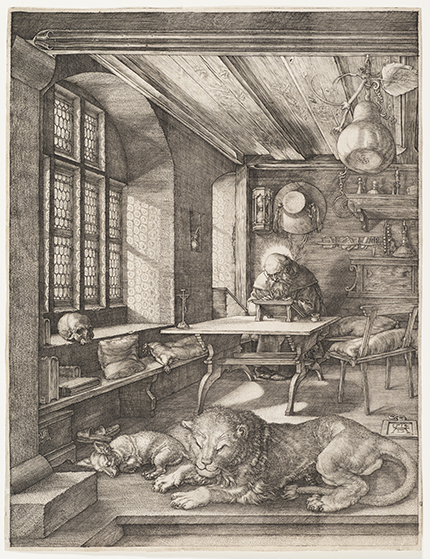November 6, 2020–February 7, 2021

Albrecht Dürer (1471–1528). Adam and Eve, Engraving, platemark: 9 5/8 x 7 1/2 in. Cincinnati Art Museum, Bequest of Herbert Greer French, 1943.193 
Albrecht Dürer (1471–1528). St. Jerome in His Study, 1514. Engraving, platemark: 9 3/4 x 7 1/2 in. Cincinnati Art Museum, Bequest of Herbert Greer French, 1943.205
NASHVILLE, Tenn. (September 23, 2020)—The Frist Art Museum presents Albrecht Dürer: The Age of Reformation and Renaissance, an exhibition featuring one hundred engravings, etchings, and woodcuts by the brilliant and versatile German Renaissance artist Albrecht Dürer (1471–1528). Organized by the Cincinnati Art Museum, the exhibition will be on view in the Frist’s Upper-Level Galleries from November 6, 2020, through February 7, 2021.
Dürer is celebrated as the greatest artist of the Northern Renaissance and one of the finest printmakers of all time. This exhibition spans nearly his entire career, from his early works as an independent master through the end of his life. It highlights the major themes of his art, such as the Apocalypse and the Passion, and his interest in nature, linear perspective, and ideal human proportions. Dürer lived in the prosperous city of Nuremberg during the advent of the Protestant Reformation, and the exhibition explores how the religious turmoil affected both the artist and his art.
“Already by the time he was thirty years old, Dürer had become the most famous artist in Europe, which is especially notable because he was a contemporary of Leonardo, Michelangelo, and Raphael,” says Frist Art Museum curator Trinita Kennedy. He achieved fame primarily with his prints, which were reproduced in multiples and sold widely.
“Inexpensive, portable, and mass produced, prints were a new medium of communication and an accessible art form that aided the spread of information and knowledge during the Renaissance, much like the internet in our own times,” says Kennedy. “By using his AD monogram as a means of declaring the authorship of images, Dürer is also a key figure in the development of modern ideas of authorship and copyright.”
Organized chronologically, the exhibition begins with an overview of Dürer’s training and early travels and then focuses on the opening of his workshop, his major works, and his later travels to Italy and the Netherlands. The exhibition concludes with a study of Dürer’s last decade and legacy.

1497–98. Woodcut (proof before text), image: 15 3/8 x 11 1/8 in.
Cincinnati Art Museum, Bequest of Herbert Greer French, 1943.212
The exhibition includes prints from five major devotional books by Dürer: the Apocalypse, the Large Passion, the Life of the Virgin, the Small Passion, and the Engraved Passion. It also features Dürer’s greatest Renaissance nudes—Nemesis (The Great Fortune) and Adam and Eve—plus outstanding exemplars of all three Master Engravings: Knight, Death, and the Devil; Melencolia I; and St. Jerome in His Study.
To provide historical context, works by Dürer’s predecessors, contemporaries, and followers are also on view, as well as maps and a timeline. A video produced by the Frist Art Museum with local artists explains the three most important printmaking techniques used by Dürer: engraving, etching, and woodcut. A seek-and-find activity encourages visitors of all ages to have fun looking closely at Dürer’s prints to discover a menagerie of animals within.
Programs
Thursday, November 12
Curator’s Perspective Presented by Kristin L. Spangenberg, curator of prints, Cincinnati Art Museum
5:30 p.m.
Free; registration required
Register here
German artist Albrecht Dürer is celebrated as one of the finest printmakers of all time. Learn more about him and about Albrecht Dürer: The Age of Reformation and Renaissance with Kristin L. Spangenberg, the exhibition’s organizer. This program will be presented on Zoom.
Spangenberg serves as curator of prints at the Cincinnati Art Museum (CAM). She has more than 45 years of experience in her field. Spangenberg earned her bachelor’s degree from the University of California at Davis and a master’s degree from the University of Michigan. She is a member of the Print Council of America, the American Historical Print Collectors Society, and the Circus Historical Society. Spangenberg has lectured on many topics, including Henri de Toulouse-Lautrec, Pablo Picasso, and Frank Duveneck. She has written catalogues for many of CAM’s exhibitions on prints, drawings, and photographs. Her essay “Frank Duveneck and the Etching Revival” will be published this year, in conjunction with CAM’s presentation of Frank Duveneck: American Master.
Thursdays, December 3, 10, and 17
Art History Course: Albrecht Dürer and His Time presented by Jim Womack, art historian and retired Jackson Family Chair of Visual and Performing Arts, Montgomery Bell Academy
11:00 a.m.–noon
This course will be hosted on Zoom.
Price per class: $12 members;
$15 not-yet-members
Price for the entire course: $30 members; $40 not-yet-members (you must register for all three classes at the same time using the discount code ALL3)
Learn more about Albrecht Dürer’s influences and his time in this three-part introductory art history course.
December 3
From the Early Woodcuts to 1504: Jubilee Year and the Possible End of the World
Register here
What prepared and helped Albrecht Dürer to become unique in his field? In this class, participants will learn about the Northern Renaissance and what distinguishes it from the late medieval era that preceded it. Artists such as the Limbourg brothers and Jan van Eyck will be considered in terms of their legacies as Dürer’s predecessors. The city of Nuremberg as a major center for printing and publishing will also be discussed.
December 10
Classicism and the Natural: Master Engravings and the Entrepreneur
Register here
What does Dürer bring back home from his first and second visits to Italy—especially from his time in Venice? How do Dürer’s travels shape his conception of himself and his role as an artist? In this session, participants will learn more about the influence of both classical art and the philosophy of humanism on Dürer’s printmaking and painting practices. The role of Maximilian I, Holy Roman Emperor, as Dürer’s patron will be discussed.
December 17
The Later Years and the Rise of German Art: Reformation and Renaissance
Register here
In this final class, participants will learn about the larger scope of German art during the Renaissance, with attention to artists such as Albrecht Altdorfer, Lucas Cranach the Elder, Matthias Grünewald, Hans Holbein, and Tilman Riemenschneider. The Reformation and its influence on art will also be discussed.
Saturday, January 23
Adult ARTLab: Drypoint Etching with Lesley Patterson-Marx
1:00–5:00 p.m.
$50 members; $60 not-yet-members
(all supplies, gallery admission, and parking validation included)
Register here
Ages 18+ only. Space is limited. Register at FristArtMuseum.org/studio by January 15. All skill levels are welcome.
In this workshop with teaching artist Lesley Patterson-Marx, students will explore drypoint etching, with works in the exhibition Albrecht Dürer: The Age of Reformation and Renaissance as their inspiration. Drypoint etching is a type of intaglioprintmaking, where the design is incised or etched into a surface with a special stylus. Prints are made by pushing ink into these sunken lines and then applying heavy pressure to transfer the design to paper. Students will deepen their understanding of Durer’s process as they create their own etchings. They will also have the opportunity to produce multiples of an image while experimenting with inking variations.
Thursday, January 28
Lecture: “Albrecht Dürer: Renaissance Art and the Transformation of the Bible” by David H. Price, professor of religious studies, Jewish studies, history, and history of art, Vanderbilt University
5:30 p.m.
Presented on Zoom
Free; registration required
Register here
Nothing is more central in the art of Albrecht Dürer than the Bible. In fact, the Northern Renaissance movement came to life as he created a new way of visualizing the Bible in his engravings and woodcuts. This lecture will invite reflection on how he portrayed the Bible as one of the great monuments of classical antiquity and also explore this question: Did Dürer’s art transform the substance of the Bible? The discussion, presented on Zoom, will focus on major works in the exhibition Albrecht Dürer: The Age of Reformation and Renaissance. David H. Price is a leading expert on Albrecht Dürer. He has written widely on the history of early modern Europe, in particular on Renaissance visual art, the history of the Bible, and Christian-Jewish relations. He is the author of nearly one hundred articles and books, including Albrecht Dürer’s Renaissance: Humanism, Reformation, and the Art of Faith (University of Michigan Press, 2003), Johannes Reuchlin and the Campaign to Destroy Jewish Books (Oxford University Press, 2012) and, most recently, In the Beginning Was the Word: Art and the Reformation Bible (Oxford University Press, 2021).
Exhibition Credit
Organized by the Cincinnati Art Museum
Supporter Acknowledgment
Supporting sponsor: The Anne and Joe Russell Family
The Frist Art Museum gratefully acknowledges the support of our Picasso Circle members in funding this exhibition.
The Frist Art Museum is supported in part by the Metro Nashville Arts Commission, the Tennessee Arts Commission, and the National Endowment for the Arts.
Connect with us @FristArtMuseum #FristDurer
FOR ADDITIONAL INFORMATION AND IMAGES
Buddy Kite: 615.744.3351, bkite@FristArtMuseum.org
Ellen Jones Pryor: 615.243.1311, epryor@FristArtMuseum.org
